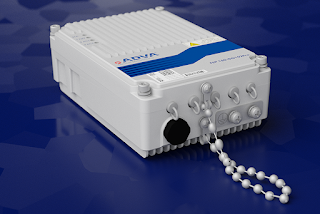Openreach, the infrastructure division of BT Group, is deploying the ADVA FSP 150-GO102Pro Series cell site gateway to enable mobile network operators (MNOs) to roll out small cell services throughout the UK.
Openreach will house the compact edge demarcation product in street furniture access points to support its Street Access service. The MEF 3.0-certified gateway will support Openreach’s 1Gbit/s Carrier Ethernet and IP services and deliver the precise phase synchronization needed for 5G mobile connectivity.
The ADVA FSP 150-GO102Pro, which is billed as the world’s smallest cell site gateway device, delivers precise time and frequency synchronization. It features automated testing and in-service monitoring and is available in two sizes. A hardened housing is sealed against water, moisture, and dust.
ADVA says this single device with standardized software-defined networking (SDN) interfaces offers a unique combination of Carrier Ethernet and IP features together with the advanced synchronization capabilities required for emerging technologies such as LTE-Advanced and 5G. The ADVA FSP 150-GO102Pro features a comprehensive set of protocols and tools for fast and efficient service activation, testing and monitoring.
With multi-layer Carrier Ethernet and IP integration, service lifecycle management and precise, assured distribution of phase and frequency synchronization, the ADVA FSP 150-GO102Pro ensures that Openreach can cover a wide range of applications with a single
demarcation product. In addition, the ADVA FSP 150-GO102Pro offers open programming interfaces, supporting bandwidth slicing, and provides deployment flexibility through moisture resistance, extended temperature range and power-over-Ethernet support.
“The ADVA FSP 150-GO102Pro is a key tool in our drive to address urgent small cell challenges. Its design and feature set enables us to roll out the highly efficient mobile backhaul architecture we need to support our 1Gbit/s Street Access product as well as LTE Advanced and 5G services,” said Mark Logan, product director, Openreach. “The ADVA FSP 150-GO102Pro requires no expensive air conditioning system. It also has an extremely compact form factor coupled with a design ruggedized to withstand harsh conditions, making it ideal for deployment in lampposts and street cabinets. And, despite being the smallest network terminating equipment solution on the market, the ADVA FSP 150-GO102Pro provides true carrier-class capabilities including automated testing, in-service monitoring and full phase sync support.”
https://www.advaoptical.com/
Openreach will house the compact edge demarcation product in street furniture access points to support its Street Access service. The MEF 3.0-certified gateway will support Openreach’s 1Gbit/s Carrier Ethernet and IP services and deliver the precise phase synchronization needed for 5G mobile connectivity.
The ADVA FSP 150-GO102Pro, which is billed as the world’s smallest cell site gateway device, delivers precise time and frequency synchronization. It features automated testing and in-service monitoring and is available in two sizes. A hardened housing is sealed against water, moisture, and dust.
ADVA says this single device with standardized software-defined networking (SDN) interfaces offers a unique combination of Carrier Ethernet and IP features together with the advanced synchronization capabilities required for emerging technologies such as LTE-Advanced and 5G. The ADVA FSP 150-GO102Pro features a comprehensive set of protocols and tools for fast and efficient service activation, testing and monitoring.
With multi-layer Carrier Ethernet and IP integration, service lifecycle management and precise, assured distribution of phase and frequency synchronization, the ADVA FSP 150-GO102Pro ensures that Openreach can cover a wide range of applications with a single
demarcation product. In addition, the ADVA FSP 150-GO102Pro offers open programming interfaces, supporting bandwidth slicing, and provides deployment flexibility through moisture resistance, extended temperature range and power-over-Ethernet support.
“The ADVA FSP 150-GO102Pro is a key tool in our drive to address urgent small cell challenges. Its design and feature set enables us to roll out the highly efficient mobile backhaul architecture we need to support our 1Gbit/s Street Access product as well as LTE Advanced and 5G services,” said Mark Logan, product director, Openreach. “The ADVA FSP 150-GO102Pro requires no expensive air conditioning system. It also has an extremely compact form factor coupled with a design ruggedized to withstand harsh conditions, making it ideal for deployment in lampposts and street cabinets. And, despite being the smallest network terminating equipment solution on the market, the ADVA FSP 150-GO102Pro provides true carrier-class capabilities including automated testing, in-service monitoring and full phase sync support.”
https://www.advaoptical.com/















